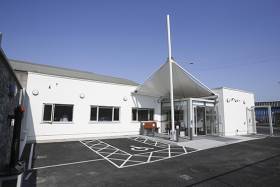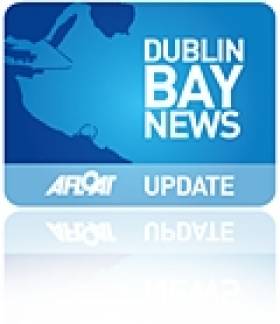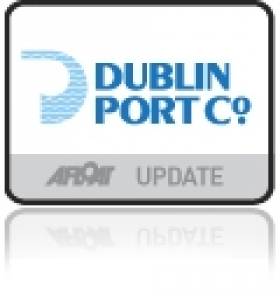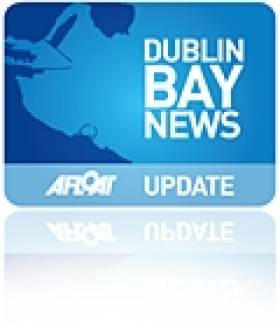Displaying items by tag: Lord Mayor of Dublin
Dublin Port Invests €0.5m in New Seafarers’ Centre
Dublin Port Company has opened a new state-of-the-art Seafarers’ Centre at Dublin Port following a €500,000 investment in the facility. The new Seafarers’ Centre was unveiled today at an official opening attended by guest of honour, the Lord Mayor of Dublin Mayor Críona Ní Dhálaigh, who is also Honorary Admiral of Dublin Port.
The Seafarers’ Centre breathes new life into the site of the old Odlums flour mill. Housed in the former Odlums workers’ canteen, which had been in use up to the mill’s closure in 2012, the Centre now provides a base for vital services to sailors docking in the port, an essential workforce of the city’s economy. Features of the old canteen building such as decking, beams and the original exterior wall have been retained and preserved as part of the new design.
As Dublin Port’s first custom-built Seafarers’ Centre, it will support over 7,500 visiting seafarers a year arriving from all over the world, typically from countries such as India, China, Ukraine, Russia and the Philippines.
In addition to Dublin Port’s €500,000 investment, the International Transport Workers’ Federation has committed €55,000 in funding towards the completion of the Centre, helping to support its role in representing the best interests of transport workers globally.
Features of Dublin Port’s purpose-built Seafarers’ Centre include free Wi-Fi access for sailors to contact family and loved ones while ashore, cooking and dining facilities, and a relaxation and recreation space including a pool table, library and TV den with beanbags.
The new Centre also brings together two long-standing traditions in caring for seafarers in Dublin, the Anglican Mission to Seafarers (The Flying Angel) and the Catholic Apostleship of the Sea (Stella Maris). Both organisations will operate together under one roof at Dublin Port to provide spiritual guidance and friendship to seafarers of all faiths, and those of none. The Flying Angel will relocate to the Seafarers’ Centre from its existing location, while Stella Maris’ presence at the Centre will complement the organisation’s existing operation at its city centre location on Beresford Place.
Ardmhéara Críona Ní Dhálaigh said at the official opening; “I mo cháil oifigiúil mar Ardmhéara agus Aimiréil Oinigh Chalafort Bhaile Átha Cliath, tá an-áthas orm an t-Ionad Mairnéalaigh nua seo a oscailt.
I commend Dublin Port for creating such a welcoming facility for the thousands of seafarers who visit our shores and make a valuable contribution to our city and society. It’s wonderful to see the Catholic Apostleship of the Sea and the Anglican Mission to Seafarers working in tandem to continue their respective traditions of caring for seafarers, and providing these workers with a home from home.”
Chief Executive of Dublin Port Company Eamonn O’Reilly said; “We are delighted to open Dublin Port’s new purpose-built Seafarers’ Centre. It means that Dublin Port can provide sailors working thousands of miles from home with a space to rest, socialise and connect with family and friends under the care of Stella Maris and the Flying Angel. The Centre is a fine example of sustainable development in practice at Dublin Port. Odlums is an iconic part of Dublin Port’s industrial heritage, and that makes today’s opening particularly special.”
#dublinbaynews – Lord Mayor of Dublin Christy Burke today called on walkers of all ages to register for the tenth annual Harbour2Harbour Walk in aid of Aware. The walk, which takes place on St. Patrick's Day, Tuesday 17th March 2015 at 10.30am will help to raise vital funds and awareness for the work of Aware, the national organisation which provides a range of support, education and information services around depression and mental health.
A fun event for an important cause, participants can choose to walk from Dun Laoghaire Harbour to Howth Harbour or vice versa along a 16.2 mile route that takes in the scenic vista of Dublin Bay. Now in its tenth year, the walk has become a hugely popular event with over 870 walkers raising €40,000 in 2014. This year Aware hopes to increase the number of participants to 1,500 and increase funds raised through participation, sponsorship and online donations from the event.
Promising a fun-filled family day out, there will be extra activities and treats along the way too thanks to Dublin Port Company. A charity partner of Aware for the organisation's 30th year, Dublin Port Company is hosting a refreshment station for all participants at Berth 18 (opposite 3 Arena), marking the mid-way point of the walk. Music and refreshments will be in full flow at Dublin Port's 'halfway hoolie' to spur walkers on the next leg of their journey!
Lord Mayor Christy Burke said: "This year's walk promises to be a fantastic day out for a very important cause. Getting out in the fresh air, taking part in exercise and being involved in group activities can all be beneficial when it comes to looking after our mental health and wellbeing, so the Harbour2Harbour Walk is a very fitting event that promises to bring family and friends together this St. Patrick's Day in Dublin."
John Fairley, Land Operations Manager, Dublin Port Company, said: "As Aware's new charity partner, Dublin Port Company is delighted to support this fantastic event. For 30 years Aware has been making a real difference to the lives of so many individuals and families across Ireland. Anyone who has attended the Harbour2Harbour Walk in previous years knows that it is an immensely enjoyable day out and this year promises to be no exception. I'd encourage walkers to sign up and make this St. Patrick's Day a day to remember."
Amo Sayed, Head of Business Development and Fundraising with Aware said: "We're really excited about this year's Harbour2Harbour Walk. Little did anyone think when the event started back in 2005 that it would still be one of Aware's most important Dublin-based fundraisers a decade later! It's a brilliant alternative on the country's national day, and we've had parents with babies in strollers, teenagers, groups of friends or colleagues, and one of our most regular walkers over the years is a man in his eighties. It really is a great day out, and yes the legs will be tired at the end of it but there's nothing like a bracing walk along the spectacular Dublin Bay to blow the cobwebs away."
The deadline for registrations for the Harbour2Harbour Walk is 14th March. Entry €25 per person available now at https://www.eventbrite.ie/e/harbour2harbour-walk-2015-dublin-tickets-15372501566. Participants are also encouraged to take a sponsorship card from Aware and raise further support for the organisation's work.
Shackleton Spearhead's Into Dublin Bay
Lord Mayor of Dublin and Admiral of Dublin Port, Gerry Breen, performed the 523 year-old "Casting of the Spear" ceremony in Dublin Bay on midsummer's day, writes Jehan Ashmore.
The 'casting' for yesterdays' re-enactment by the Lord Mayor took place onboard the Dublin port Company tug Shackleton.
From the deck of the Spanish built 50-tonne bollard pull tractor-tug, a spear was launched into the sky and fell deep into the cold water's of Dublin Bay. The ceremony once again marked the position of the city boundaries eastwards.
The medieval tradition of 'Casting of the Spear' dates back to 1488 when the then Lord Mayor, Thomas Mayler, set out on his horse to ride the city's boundaries.
According to historical records he rode out onto the strand as far as a man might ride and from there he cast a spear into the sea. At that time, casting the spear demonstrated the extent of the city boundaries eastwards.
The tradition marks one of many significant moments in Dublin Port's long history since its establishment as a trading post some 1,200 years ago.
Lord Mayor to Preside over Old Gaffers' Parade of Sail
Dublin's Lord Mayor Gerry Breen will assume the traditional title of Admiral of the Port of Dublin when he presides over the Parade of Sail on the Liffey later this month.
The parade on Sunday 29 May is a highlight of the annual Dublin Bay Old Gaffers Association rally, which this year is held in tandem with the Stella Maris Rowing Club regatta.
Rowing clubs along the east coast will be sending crews to Dublin to compete for the special Asgard Trophy, which is made of timber used in the conservation of the original Asgard in the National Museum.
The event - centred at the Poolbeg Yacht and Boat Club near Ringsend - is also expected to attract classic vessels from ports in Wales and Northern Ireland.
For more information contact the Dublin Bay Old Gaffers Association at www.dublinbayoldgaffersassociation.com or [email protected]
The Old Gaffers Association is a sailing organisation dedicated to preserving traditional sailing craft, usually former working boats, and mainly of wooden construction, promoting their distinctive gaff rig.
































































